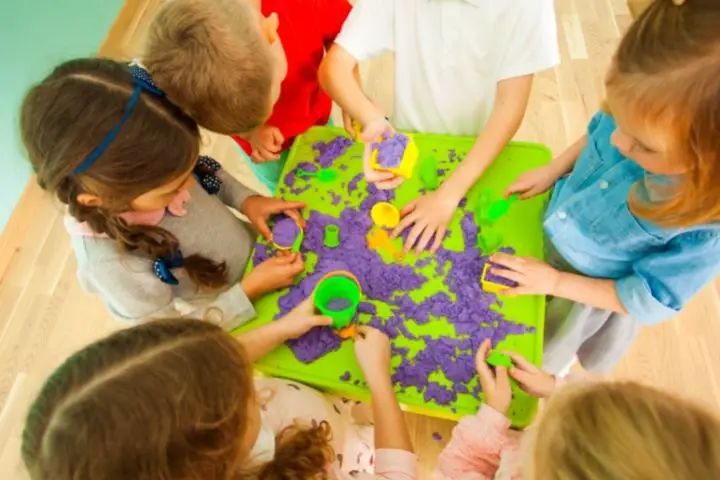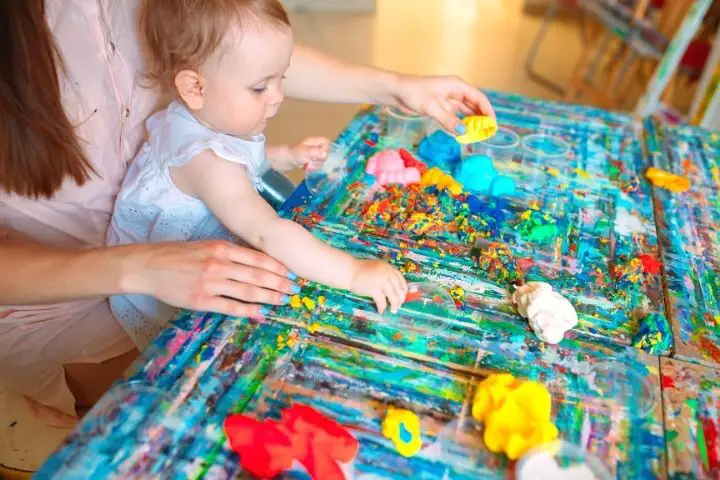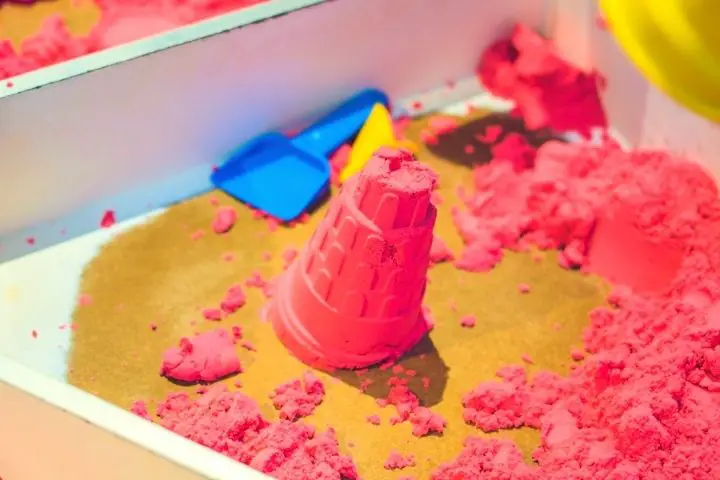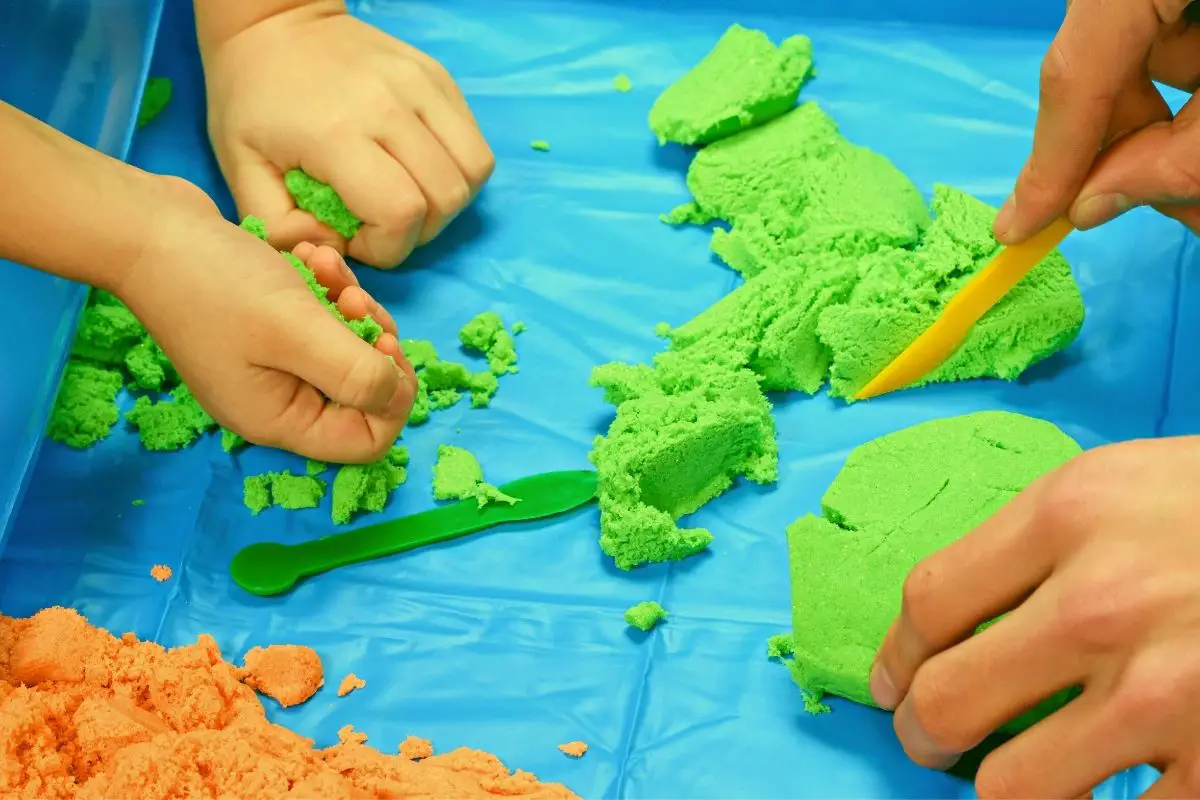Moon Sand vs Kinetic Sand | What’s the difference?
When it comes to creating unique play experiences, you can’t beat the versatility of sand!
If you’re looking for an alternative to regular play sand, then something like moon or kinetic sand might be on your radar.
The differences between moon sand vs kinetic sand are small but noticeable. But both products are kid-safe and provide tons of creative and sensory-rich fun.
One formula could be better for your family than the other. Or you might decide it’s worth having both in your play sand repertoire!
What Is Moon Sand?
You may be familiar with the discontinued Moon Sand brand from several years ago. Today, the name “moon sand” is still used for a variety of homemade recipes that replicate the old store-bought version.
In its current iteration, moon sand is a fun alternative to clay or play dough. It is extremely moldable but doesn’t dry out.
Not all moon sand recipes call for actual sand. So, depending on the recipe followed, moon sand may be safer for babies and young children than alternatives.
How to Make Moon Sand

The most popular recipe for DIY moon sand calls for just two ingredients:
- 8 parts flour
- 1 part oil
- Dash of food coloring (optional)
Or, you can make a more authentic version of the original Moon Sand using play sand and some pantry items:
- 5 parts play sand
- 3 parts cornstarch
- 1 part oil
- Dash of food coloring (optional)
Regardless of the recipe, mix the ingredients by hand until fully combined. Store in an airtight container when not in use.
What Is Kinetic Sand?
Kinetic Sand is a brand name (though, unlike Moon Sand, the product is still on store shelves).
You can also find a handful of DIY recipes for kinetic sand online. But most people agree that true kinetic sand is made by coating regular sand particles with silicone.
This silicone layer gives kinetic sand a damp, moldable texture that doesn’t dry out. It also prevents the sand particles from really sticking together.
While you can press kinetic sand into different shapes, it won’t hold them for long. Kinetic sand’s tendency to return to its original shape is what gives it its name.
What Is the Difference Between Magic Sand and Kinetic Sand?

Like kinetic sand, magic sand is a type of chemically coated play sand. In the case of magic sand, the chemical coating is trimethylhydroxysilane. But there is a key difference in how these sands behave…
A more appropriate name for magic sand would be “hydrophobic sand.” In other words, this sand is specifically designed to repel water.
When handled out of the package, magic sand acts and feels just like normal sand. But when you submerge the sand underwater, it takes on the moldable properties of materials like moon or kinetic sand.
Another interesting quirk of magic sand’s hydrophobic coating is that it never gets wet. If you pour away the water it’s submerged in, you’ll be left with a completely dry pile of sand!
Moon Sand vs Kinetic Sand
Texture
Texture is the most noticeable difference between moon sand and kinetic sand. While kinetic sand feels like a finer version of wet beach sand, moon sand tends to have a consistency similar to clay or play dough. Moon sand also crumbles much more readily than other types of play sand.
Shelf Life
Both moon sand and kinetic sand are beloved for being long-lasting. However, kinetic sand tends to retain its quality for longer than moon sand.
No matter which formula you prefer, it’s a good idea to store the sand in an airtight container when not in use. This will keep it soft and moldable for as long as possible.
Safety

You can rest easy knowing that both moon sand and kinetic sand are non-toxic and safe for children.
Kinetic sand (and moon sand recipes containing sand) are safe for any kid who knows not to eat sand. In most cases, this includes children ages 3 and up.
For younger kids, a moon sand recipe made with just flour and oil is the safest option. While this mixture is 100% edible, supervision is still recommended!
Uses
Kids will come up with all kinds of ways to play with these sands. It’s impossible to say one is inherently better than the other!
With that said, moon sand is ideal for children who enjoy molding and building. It holds its shape a little better and can support sandcastles and other creations.
Meanwhile, kinetic sand excels as a sensory toy. Its slippery, ever-moving texture offers a unique experience for kids who like to dig, squeeze, and stretch.
Mess
By most accounts, moon sand is slightly messier than kinetic sand. Keep this in mind when setting up a safe play area so you can plan ahead for easy clean-up!
Frequently Asked Questions

Is Kinetic Sand the Same As Moon Sand?
While they are both types of play sand, kinetic sand and moon sand are not the same thing. The main difference is that moon sand readily holds its shape while kinetic sand naturally wants to revert to its original shape.
Does Moon Sand Dry Out?
One of the great things about moon sand is it won’t dry out while being played with. But that doesn’t mean it will last forever.
Store moon sand in an airtight container when not in use. In most cases, moon sand will keep for 1 to 2 months.
Can You Fill a Sandbox With Kinetic Sand?
Yes, you can use kinetic sand in a sandbox!
Kinetic sand, among other child-safe sand alternatives, is a very popular choice for sensory tables and boxes. You could also, theoretically, fill a traditional sit-in sandbox with kinetic sand. However, this would be much more expensive than using regular play sand!
Is Kinetic Sand Hard to Clean Up?
No, kinetic sand is easy to clean as long you know the right strategy.
One of kinetic sand’s defining qualities is its tendency to stick to itself. You can use this to your advantage when it comes time to clean up your child’s play surface! Just use a ball of kinetic sand to pick up any loose grains.
To remove kinetic sand from fabric or carpeting, you can use a combination of dish soap, sweeping, and vacuuming to clean up any mess.





